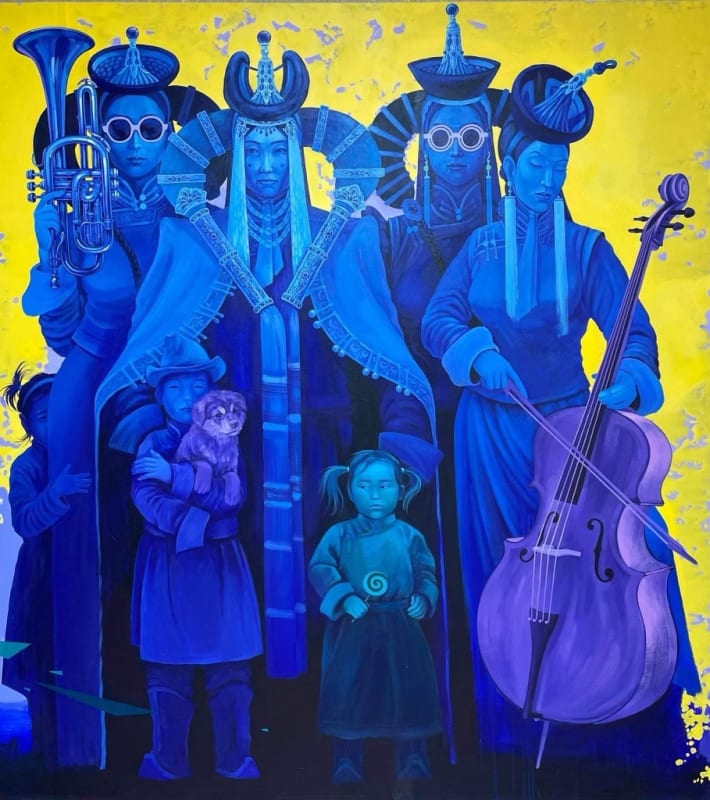Artists Talk on Art Presents:
Mongolian Artist Zaya Saikhan-Sambuu
Interviewed by
Author and Art Historian Dr. Gail Levin
Monday May 1st, 2023 7:00 PM - 8:30 PM EST (Zoom)
Zaya Saikhan Sambuu Artist Zaya was born Zayasaikhan Sambuu in 1975 in Mongolia, in an isolated village in the Gobi Desert. At fifteen he decided to become a Buddhist monk. but the strict rules of the monastery were at odds with his irrepressible creativity. By the time he was a teenager, communist Mongolia was becoming less oppressive, and freedom of religion returning. Zaya was noticed for his talent in drawing, and started by drawing scenes of Buddhism, which was resurfacing after years of suppression. At 17 he enrolled in the Soyol Fine Art College in Ulaanbatar (the capital of Mongolia). There, traditional Mongolian art was taught. He continued his studies at the Mongolian State University of Arts and Culture, from which he obtained his bachelor's degree in 2002. In 2015 he showed a series of ink-and-watercolor paintings in San Francisco, inspired by Genghis Khan, his life and warriors. Of the latter paintings was said: "Combining traditional Mongolian styles with Japanese art techniques, the striking, highly detailed images bring these warriors and their era to life." https://www.instagram.com/artofzaya/?hl=en
Dr. Gail Levin is Distinguished Professor of Art History, American Studies, and Women's Studies at The Graduate Center and Baruch College of the City University of New York. The acknowledged authority on the American realist painter Edward Hopper, she is author of many books and articles on this artist, including the catalogue raisonné and Edward Hopper: An Intimate Biography. Her work on twentieth century and contemporary art has won international acclaim, been widely published, and translated in Europe, Asia, and Australia. Articles range from theory of artists' biographies to explorations of the intersection of American and Asian cultural studies.She has also focused on the art of Jewish women artists in historical context. Her interest in women artists led to biographies of Judy Chicago (2007; 2018) and of Lee Krasner (2011; 2019). Her project, Theresa Bernstein: A Century in Art, included a book, (2013) a comprehensive website, and a touring exhibition; it was the product of her collaboration with several scholars including her doctoral students at the Graduate Center. Gail Levin is not only a curator, but also shows her own work as an artist and photographer. In her Hopper's Places (1985, 1998) and Marsden Hartley in Bavaria (1989), she found and identified the art works and the exact places they depicted. She then photographed and analyzed how the painters transformed the scenes. These projects, which resulted in both books and exhibitions, she considers conceptual art, thinking along lines sketched by Sol LeWitt. "In conceptual art the idea or concept is the most important aspect of the work. When an artist uses a conceptual form of art, it means that all of the planning and decisions are made beforehand and the execution is a perfunctory affair. The idea becomes a machine that makes the art." (Sol LeWitt "Paragraphs on Conceptual Art," Artforum, June 1967.) As has happened with LeWitt's wall drawings, others have emulated Levin's photographs of Hopper's scenes. After research into the lives of other artists, Levin has produced a collage memoir that brings a singular perspective to her own life in art. Even while active as an art historian and curator, she was producing photographs, collages, paintings, and prints. Her collage memoir, "On NOT Becoming an Artist: A Retro-Spective," begins with her earliest self-portrait and then shows and tells her story of growing up in the Deep South, where her parents threatened to disown her if she became an artist. Successive collages trace her journey into the worlds of museums and art history, exploring the sometimes-blurred lines between art, art history and criticism. Info: gail.levin@baruch.cuny.edu
Artists Talk on Art Presents: Mongolian Artist Zaya Saikhan-Sambuu Interviewed by Author and Art Historian Dr. Gail Levin
Copyright © 2025 532 Gallery
© 532 Gallery | +41 783 49 03 00 | info@532gallery.com
Facebook, opens in a new tab.
Instagram, opens in a new tab.
Send an email
This website uses cookies
This site uses cookies to help make it more useful to you. Please contact us to find out more about our Cookie Policy.
Join our mailing list
* denotes required fields
We will process the personal data you have supplied in accordance with our privacy policy (available on request). You can unsubscribe or change your preferences at any time by clicking the link in our emails.

